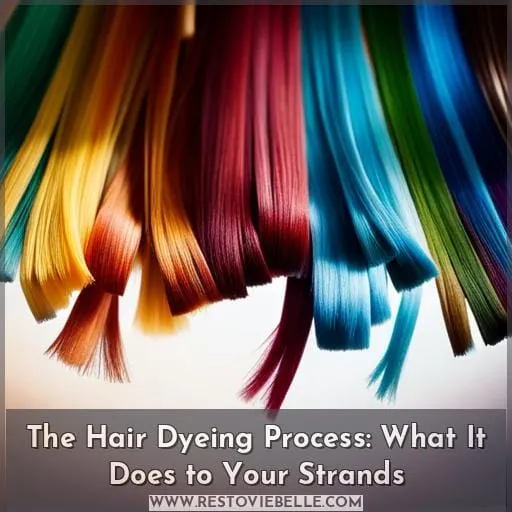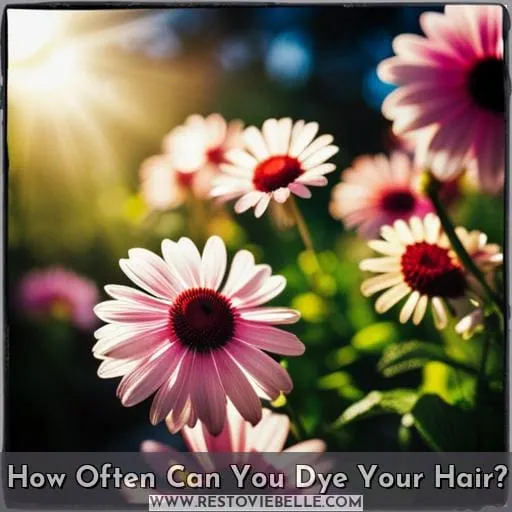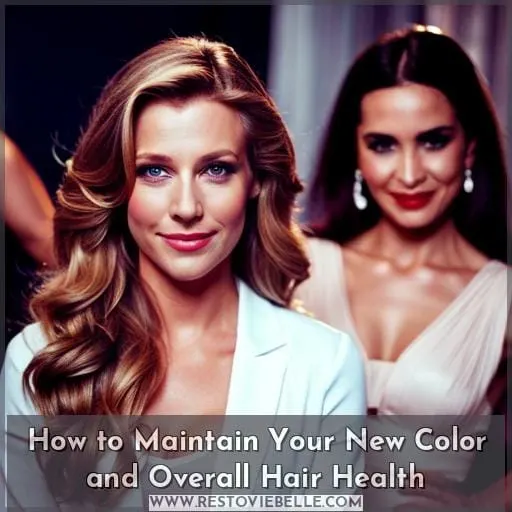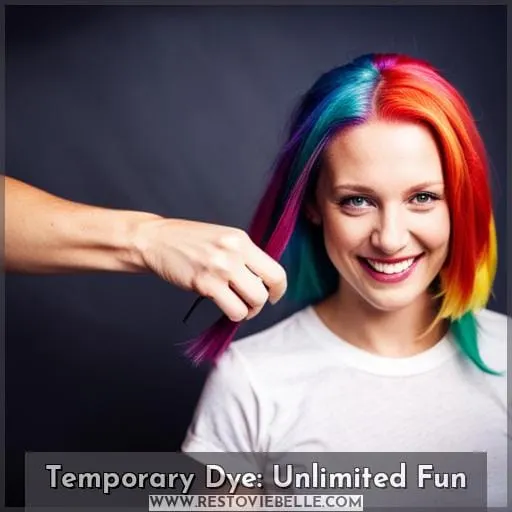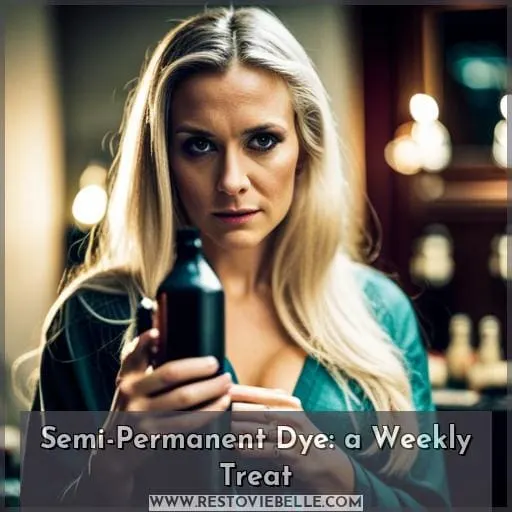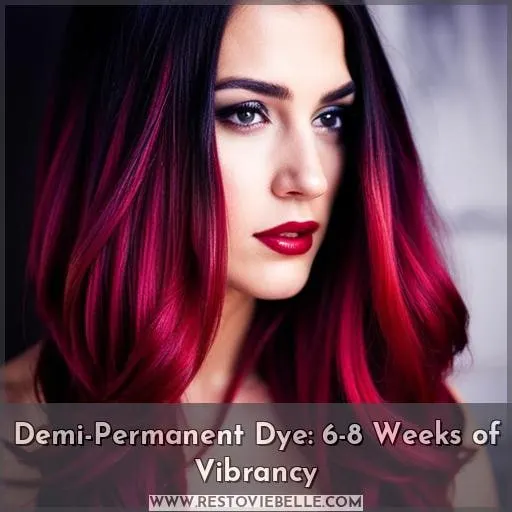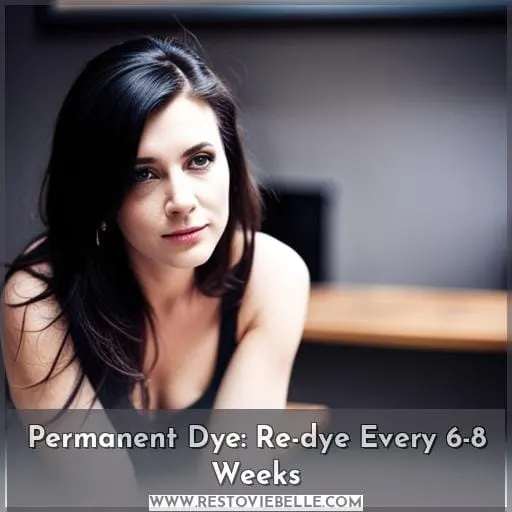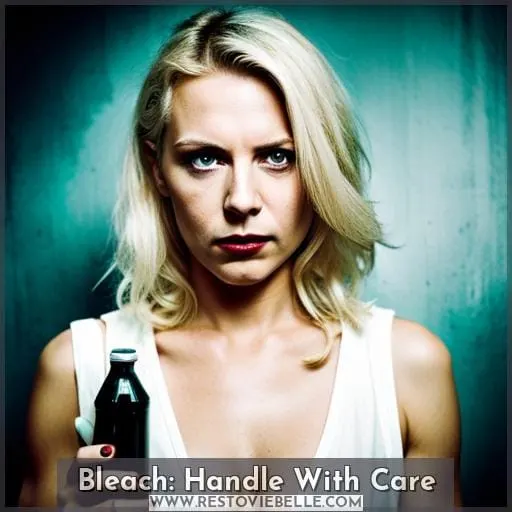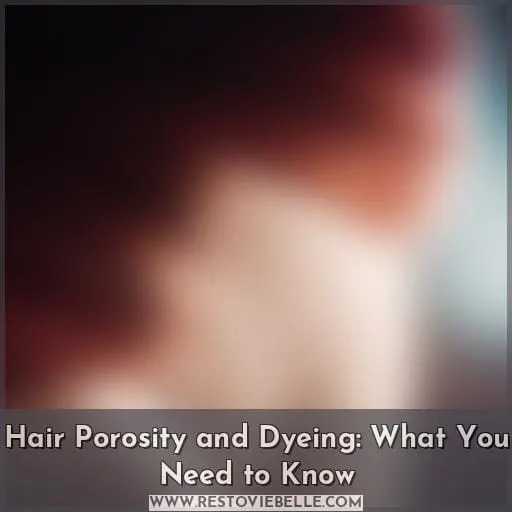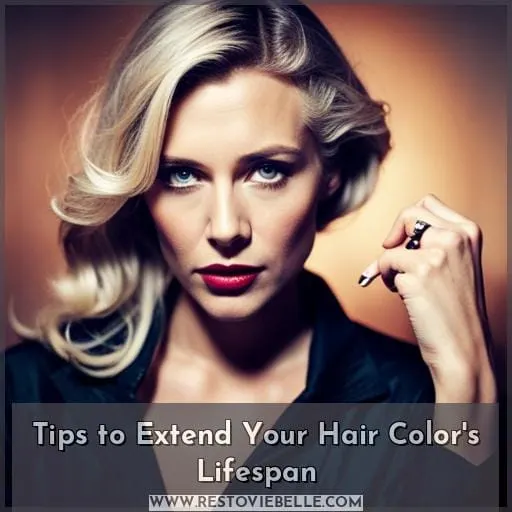This site is supported by our readers. We may earn a commission, at no cost to you, if you purchase through links.
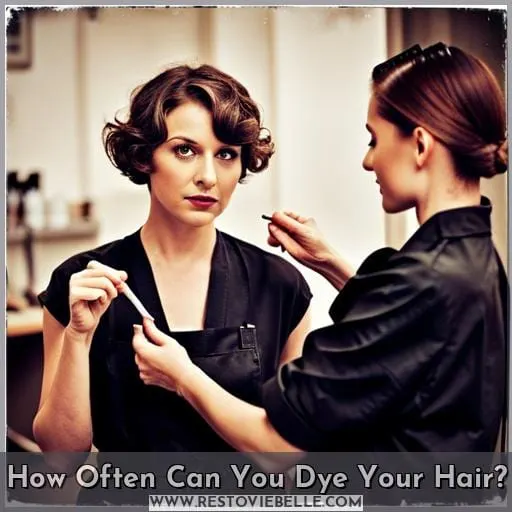 Ready for a hair transformation? You might be wondering just how often you can dye your hair without causing damage. Well, look no further! In this article, we’ll dive into the world of hair dyeing and explore the recommended frequency to keep your locks healthy and vibrant.
Ready for a hair transformation? You might be wondering just how often you can dye your hair without causing damage. Well, look no further! In this article, we’ll dive into the world of hair dyeing and explore the recommended frequency to keep your locks healthy and vibrant.
From temporary dyes to permanent colors, we’ve got all the tips you need to maintain your fabulous new hue.
Table Of Contents
- The Hair Dyeing Process: What It Does to Your Strands
- How Often Can You Dye Your Hair?
- How to Maintain Your New Color and Overall Hair Health
- Temporary Dye: Unlimited Fun
- Semi-Permanent Dye: a Weekly Treat
- Demi-Permanent Dye: 6-8 Weeks of Vibrancy
- Permanent Dye: Re-dye Every 6-8 Weeks
- Bleach: Handle With Care
- Hair Porosity and Dyeing: What You Need to Know
- Tips to Extend Your Hair Color’s Lifespan
- Conclusion
The Hair Dyeing Process: What It Does to Your Strands
You should carefully consider how frequently you dye your hair, as the process can have varying effects on your strands.
The hair dyeing process involves applying color to your hair, which can affect its cuticles and overall health.
Hair cuticles are the outer layer of each strand that protect it from damage.
When you dye your hair, the chemicals in the dye penetrate these cuticles to change its color. This process can cause some level of damage to your strands depending on factors like porosity and previous coloring treatments.
Hair porosity refers to how easily moisture and substances like dyes can be absorbed by your strands. If you have high-porosity hair, it may absorb more color but also fade faster over time compared to low-porosity hair types.
How Often Can You Dye Your Hair?
When dyeing your hair, it’s important to consider how often you can color your strands without causing damage.
- Hair type: Different hair types have varying levels of resilience and strength. Thicker and healthier hair can withstand more frequent coloring compared to finer or damaged strands.
- Hair health: If your locks are already compromised due to excessive heat styling, chemical treatments, or over-processing, it’s best to give them time to recover before applying more color.
- Hair porosity: Porous hair tends to absorb color quickly but also fades faster. Adjust the frequency accordingly if you have high-porosity strands that require more frequent touch-ups or low-porosity tresses that hold onto color longer.
- Hair Color Longevity: Consider how long you want your new hue last – if longevity is essential for maintaining vibrancy, a longer interval between dyes may be necessary.
By taking into account these factors and listening closely to your hair, you can avoid damaging your strands and achieve the vibrant color you desire.
How to Maintain Your New Color and Overall Hair Health
To maintain your new hair color and overall hair health, it’s important to:
- Prioritize conditioners.
- Protect against heat.
Conditioners help nourish and hydrate your strands, keeping them healthy and vibrant. Heat protection products shield your hair from damage caused by styling tools, ensuring that your color stays intact for longer.
By incorporating these steps into your routine, you can enjoy beautiful colored locks while maintaining the health of your hair.
Prioritize the Conditioners
To maintain your new hair color and overall hair health, it’s essential to prioritize the use of conditioners.
Deep conditioning once a week can help restore moisture and nourish your colored locks.
When choosing a conditioner, opt for one that’s specifically formulated for color-treated hair and avoid sulfates that can strip away color.
Additionally, using a heat protectant before styling with hot tools can prevent damage to your dyed strands.
Remember to trim split ends regularly to keep your hair looking healthy and vibrant.
Protect Against the Heat
To maintain your new hair color and overall hair health, it’s important to protect against the damaging effects of heat.
- Use a heat protectant before using any hot tools.
- Avoid excessive use of hot styling tools and opt for cool settings whenever possible.
- When blow-drying, use a low-heat setting or allow your hair to air dry naturally.
By following these tips, you can keep your color vibrant while promoting healthy-looking hair.
Temporary Dye: Unlimited Fun
You can use temporary dye as often as you want to add some fun and vibrant colors to your hair.
Temporary dyes offer a no-commitment option, allowing you to experiment without causing any damage.
These dyes are easy to apply and come in a variety of shades that can instantly transform your look.
With their quick application process, you can switch up colors frequently for unlimited fun!
To ensure the longevity of your temporary color, it’s important to use color-safe shampoo when washing your hair.
So go ahead and unleash your creativity with temporary dye – there are no limits when it comes to expressing yourself through colorful hair!
Semi-Permanent Dye: a Weekly Treat
You can safely dye your hair with semi-permanent dye once a week.
This type of dye is a great option for those who want to experiment with different colors without the commitment or potential damage associated with permanent dyes.
Semi-permanent dyes are designed to fade gradually over time, allowing you to switch up your look regularly.
However, it’s important to keep in mind that the longevity of the color will depend on various factors such as hair porosity and maintenance routine.
To ensure your color stays vibrant and lasts longer, use color-safe products and avoid harsh chemicals that can cause fading or damage.
If you ever need any touch-ups or color correction, consult a professional hairstylist who can guide you through proper upkeep techniques for maintaining beautiful colored locks.
Demi-Permanent Dye: 6-8 Weeks of Vibrancy
For vibrant, long-lasting color, demi-permanent dye should be reapplied every 6 to 8 weeks. This type of dye offers a range of benefits and considerations compared to permanent dyes.
- Demi-permanent dye provides intense color that lasts for several weeks without the commitment of permanent dye.
- It can also enhance hair’s natural shine and condition due to its conditioning properties.
- While demi-permanent dyes fade gradually over time, they may not completely wash out like temporary or semi-permanent dyes.
- Additionally, since these dyes raise cuticle scales to penetrate the hair shafts partially, they may cause slight damage with repeated use.
Aftercare is crucial for maintaining your demi-permanent color’s vibrancy:
- Use sulfate-free shampoos specifically formulated for colored hair.
- Avoid excessive heat styling tools that can accelerate fading.
- Regularly deep condition your locks to keep them moisturized and healthy.
Popular brands known for their quality demi-permanent options include Wella Color Charm Demi-Permanent Hair Color, Redken Shades EQ Gloss Processing Solution Hair Dye Kit Salon Professional (Shades EQ), and Clairol Natural Instincts Semi-Permanent Hair Dye Kit among others in the market today.
Permanent Dye: Re-dye Every 6-8 Weeks
To maintain long-lasting vibrancy, it’s recommended that you re-dye your hair with permanent dye every 6-8 weeks.
Permanent dye provides the most intense and long-lasting color results compared to other types of dyes. However, over time, factors such as hair porosity, bleach damage, and exposure to sunlight can cause color fading.
By re-dyeing your hair every 6-8 weeks, you can ensure that your color remains vibrant and true-to-tone for an extended period. Additionally, regular touch-ups help in maintaining consistent shade throughout your hair while also allowing for any necessary color correction if needed.
Remember to follow proper aftercare routines using color-safe products and minimizing heat styling to maximize the longevity of your freshly dyed locks.
Bleach: Handle With Care
When it comes to bleach, handle this hair dye with care. Bleach can be a powerful tool for achieving lighter hair color or highlights, but it also has the potential to cause damage if not used properly.
-
Protect your hair’s porosity:
- Bleach opens up the cuticle of your hair strands, making them more porous and susceptible to damage.
- It’s crucial to assess your hair’s porosity before using bleach and adjust the processing time accordingly.
-
Minimize damage:
- Bleaching can strip moisture from your strands and leave them dry and brittle.
- To minimize damage, use a deep conditioning treatment before bleaching and follow up with regular moisturizing treatments after.
-
Avoid over-processing:
- Using bleach too frequently or leaving it on for too long can lead to excessive damage and breakage.
- Give your hair ample time between bleaching sessions (at least 8-10 weeks) for optimal health.
-
Haircare routine adjustments:
- After using bleach, switch to gentle shampoos specifically formulated for color-treated tresses that will help maintain vibrancy without stripping away additional moisture.
Hair Porosity and Dyeing: What You Need to Know
Now that you have a better understanding of how to handle bleach, let’s dive into another important aspect of hair dyeing: hair porosity.
Understanding your hair’s porosity levels is crucial for achieving the desired results and maintaining healthy tresses. Porosity refers to how well your hair absorbs and retains moisture, which directly affects dye penetration and color longevity.
The porosity scale ranges from low to high, with low-porosity hair having tightly closed cuticles that make it difficult for dyes to penetrate deeply. On the other hand, high-porosity hair has open cuticles that readily absorb color but may also cause faster fading.
To determine your porosity level, consider factors such as previous chemical treatments or heat damage as they can affect the structure of the hair.
Tips to Extend Your Hair Color’s Lifespan
To extend the lifespan of your hair color, there are several tips you can follow:
First, use color-safe products that won’t strip or fade your color.
Additionally, prioritize conditioners to keep your hair moisturized and protected.
Finally, avoid heat styling as much as possible and limit exposure to harsh chemicals that can cause damage and fading.
By following these tips, you can maintain vibrant and long-lasting hair color between dyeing treatments.
Avoid Over-Shampooing
If you want to maintain your hair color for a longer period of time, it’s important to avoid over-shampooing.
Over-shampooing can strip away the color and cause it to fade faster.
Instead, focus on deep conditioning your hair regularly to keep it moisturized and vibrant.
Additionally, trimming split ends regularly will prevent them from spreading further up the hair shaft and potentially affecting the colored sections.
To protect your color from heat damage, make sure to use a heat protectant before styling with hot tools.
Lastly, avoid harsh chemicals that can further weaken and dull your colored strands.
Incorporate Scalp Scrubs
To extend the lifespan of your hair color, incorporate scalp scrubs into your routine.
Scalp exfoliation is a crucial step in maintaining vibrant and long-lasting hair color.
By using scalp scrubs regularly, you can:
- Reduce hair loss
- Stimulate hair growth
- Improve hair texture
- Detoxify your scalp
These benefits are achieved by removing buildup from styling products and dead skin cells that can dull your color and weigh down your strands.
Make sure to choose gentle yet effective scrubs specifically formulated for the scalp to avoid irritation or damage.
Conclusion
Ready to rock a new hair color?
[Keypoints]The frequency at which you dye your hair depends on the type of dye you choose.
- Temporary dyes allow for unlimited fun, while semi-permanent dyes can be a weekly treat.
- Demi-permanent dyes offer 6-8 weeks of vibrancy, while permanent dyes require re-dyeing every 6-8 weeks.
Just remember to handle bleach with care.
To maintain your new color and overall hair health, prioritize conditioners and protect against heat.
Now go ahead, dye your hair and rock that fabulous new hue!
